
The Importance of Vernal Pools
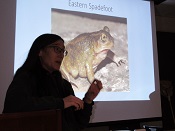
Karen Sheffield explored the characteristics and importance of vernal pools to a rapt audience of 60 on March 3, 2019 at a meeting sponsored by the Friends of Dyke Marsh, Friends of Huntley Meadows Park, Friends of Mason Neck State Park and Friends of Accotink Creek. Ms. Sheffield is the manager of Huntley Meadows Park and Historic Huntley, Fairfax County Park Authority, and oversees a survey of vernal pools there.
Connecting to the Larger Community
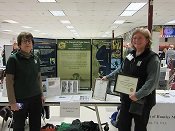
On February 2, 2019, the Friends of Dyke Marsh again participated in Mount Vernon Supervisor Dan Storck's annual town meeting at Mount Vernon High School, at which Supervisor Storck and other officials reviewed his accomplishments and challenges facing the community. FODM had a table and materials in the exhibit hall alongside other friends’ groups. FODM volunteers greeted visitors and informed them about Dyke Marsh, the restoration project and FODM’s activities and goals.
Restoration Work Advances
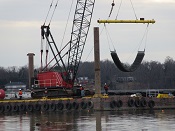
In early January 2019, the Dyke Marsh restoration breakwater became more and more visible as crews from Coastal Design and Construction continued to install 50 to 55 “marine mattresses” each working day. By January 8, they had placed 2,900 in the south marsh. On January 9, crews on a work barge and a rock barge began putting armor stone on top of the mattresses near the shoreline. A surveyor on the shoreline monitors the tide level and helps ensure that the mattresses are placed at the right elevation.
The Government Shutdown: Bird Walks Continue; Report Harm
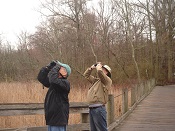
During the current federal government closure, as of January 2, 2019, people can access the Dyke Marsh Wildlife Preserve trail and our Sunday, 8 a.m., bird walks are allowed. Therefore, the walks will resume on January 6. All restrooms are closed.
The National Park Service website (www.nps.gov) says that “for most parks, there will be no National Park Service-provided visitor services, such as restrooms, trash collection or facilities or road maintenance.”
Students Explore Dyke Marsh
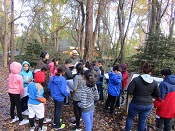
On November 8, 2018, 37 enthusiastic fourth graders from the Arlington’s Randolph Elementary School explored the Dyke Marsh Wildlife Preserve with National Park Service staffers Brent O'Neill, Miguel Roberson and Susan Chumley, along with FODM volunteers.
The GW Memorial Parkway's Rich Biodiversity
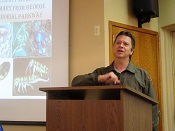
On November 14, 2018, Brent Steury, Natural Resources Manager for the George Washington Memorial Parkway, told 65 FODMers and friends that the parkway is rich and biodiverse in its natural resources in a presentation describing the Parkway’s all-taxa inventory. The Parkway is a national park of which the Dyke Marsh Wildlife Preserve is a unit.
Dyke Marsh West
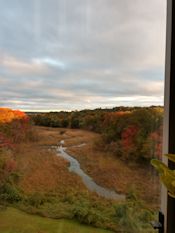
Around 15 to 20 acres of Dyke Marsh stretch west of the George Washington Memorial Parkway behind the Belle Haven and River Towers Condominiums. This part of the marsh can be seen from the parkway and the condos, but it is not easily accessible to the public. Several FODMers regularly observe this part of Dyke Marsh.
FODMers Participated in the Environment Expo
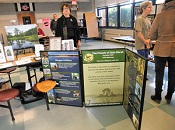
The Friends of Dyke Marsh exhibited at Fairfax County Board of Supervisors’ Mount Vernon Supervisor Dan Storck’s Environment Expo on November 10, 2018, an event which Supervisor Storck hopes to hold again. Over 130 people attended and were inspired to become better environmental stewards in eight workshops and in watching the movie “Hometown Habitat.”
Breakwater’s Base Being Built
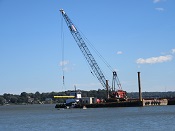
In mid-October 2018, crews from Coastal Design and Construction continue to build a breakwater in Dyke Marsh to help stop erosion and encourage sedimentation, the first stage of marsh restoration. As of October 17, 2:30 p.m., the team had installed three layers of “marine mattresses” or 1,624 units. The total final number will depend on the depth of the river bottom. A new barge load will arrive soon.
Planting Again to Restore Habitat with Native Plants
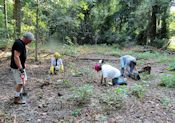
On October 4, 2018, ten dedicated FODM volunteers and National Park Service staffers put in another 400 or so plants in our native plant demonstration area along the west side of the Haul Road trail, bringing our total plantings this year to around 3,500. Despite the oppressive heat and a “healthy population” of mosquitoes, “It was a true labor of love,” said Ned Stone, FODM Vice President.
Volunteers Collect 50 Bags of Never-ending Trash
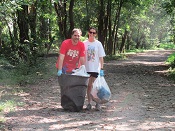
The Friends of Dyke Marsh and the National Park Service hosted 35 volunteers, ages five to unknown, who collected 50 big bags of trash for three hours along the Potomac River and Dyke Marsh shoreline during low tide on September 22.
How Plants Support Insects, Birds and other Wildlife
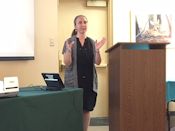
Dr. Desiree Narango, an ecologist, gave a presentation to 70 people on September 12, 2018, explaining how native and non-native plants affect breeding bird populations, behavior and food web interactions. She worked with the Smithsonian Institution's Neighborhood Nestwatch program which focuses on breeding birds in urban/suburban backyards. Like most songbirds, Carolina chickadees are very dependent on caterpillars and other insects when raising their young. A chickadee with four to seven young, needs between 390 to 570 caterpillars every day to feed their young. Caterpillars are very dependent on certain host plants.


AlbertHerring-b4cc6b5cfb.jpg)



 Friends of Dyke Marsh, Inc. is a non-profit 501(c)(3) organization.
Friends of Dyke Marsh, Inc. is a non-profit 501(c)(3) organization.